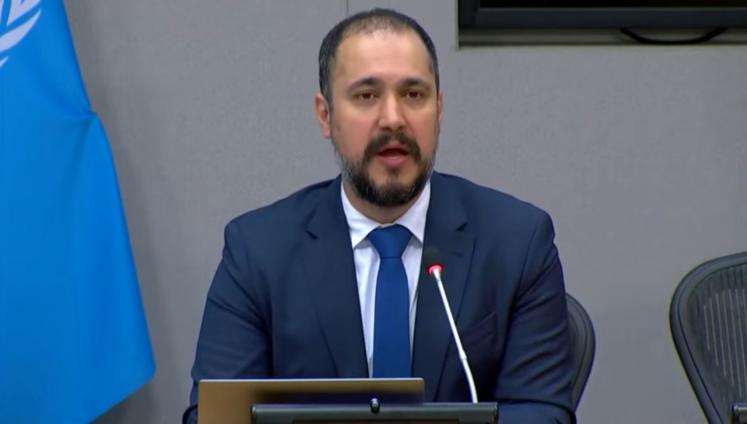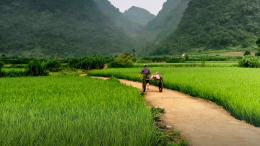Three out of four people currently live in water-insecure countries. More people die from a lack of safe drinking water, sanitation, and hygiene (WASH) services than water-related disasters, reveals the new United Nations University Global Water Security 2023 Assessment.
•••
23 March 2023, New York, USA — A global water security assessment led by United Nations water experts found that the majority of the world’s population currently live in water-insecure countries. This is a cause for major concern because water security is fundamental to development.
The Global Water Security 2023 Assessment released on the second day of the UN 2023 Water Conference provides a multidimensional comparison of the state of water security affecting 7.8 billion people across 186 countries midway into the Water Action Decade (2018–2028) and the 2030 Agenda for Sustainable Development. The report provides some very alarming statistics, arguing that the world is far from achieving “clean water and sanitation for all” known as Sustainable Development Goal (SDG) 6.
“Without water security, countries are simply incapable of supporting freshwater ecosystems, livelihoods and human well-being,” said Dr Charlotte MacAlister, the report’s lead author and senior water security researcher at the United Nations University Institute for Water, Environment and Health (UNU-INWEH). “This global assessment highlights significant development challenges that policy discussions should centre on in the seven years left to fulfill SDG 6.”
Based on the assessment published by UNU-INWEH, also known as the UN Think Tank on Water, policymakers are mainly focused on water scarcity mitigation around the globe. The authors argue that this reductionist interpretation of water security has put the world off-track to meeting SDG 6 by 2030.
To provide a more realistic understanding of the water security status around the world, this UNU-INWEH report evaluated water security on 10 components or dimensions: drinking water, sanitation, good health, water quality, water availability, water value, water governance, human safety, economic safety, and water resource stability. The results are worrying: 78% of the global population (6.1 billion people) presently live in water-insecure countries.
UNU-INWEH’s Director, Professor Kaveh Madani, noted the value of this first global outlook of water security as “a major contribution” to the UN 2023 Water Conference taking place from March 22–24 in New York. “While not an easy undertaking, this research identifies where we should target policy, funding, and action to accelerate progress, meet the 2030 Agenda and ensure that the most vulnerable and insecure are not left behind.”
The global assessment’s key findings include:
Unless radical action is taken, this assessment indicates that two-thirds of the world’s population will continue to live water-insecure well beyond 2030.
###
Global Water Security 2023 Assessment by the United Nations University Institute for Water Environment and Health, is available online at: https://inweh.unu.edu/global-water-security-2023-assessment/
Media contact
Dr Zeineb Bouhlel, zeineb.bouhlel@unu.edu
The Team is available for interviews:
Dr Charlotte MacAlister, charlotte.macalister@unu.edu
Dr Lina Taing, lina.taing@unu.edu
Prof. Kaveh Madani, kaveh.madani@unu.edu
The Team will also take part in a press conference on Thursday, 23 March 2023 at 11:00 US ET / 15:00 GMT at the United Nations 2023 Water Conference, UN Headquarters Media Centre, New York.
The Press Conference will be broadcast live on UN Web TV at: https://media.un.org/en/webtv
- While all regions have countries with low levels of water security, Least Developed Countries (LDCs) and Small Island Developing States (SIDS), in particular, face critical levels of water security due to a range of compounding factors. A total of23 countries — 16 LDCs and 7 SIDS — are critically water-insecure: the Solomon Islands, Eritrea, Sudan, Ethiopia, Vanuatu, Afghanistan, Djibouti, Haiti, Papua New Guinea, Somalia, Liberia, St Kitts & Nevis, Libya, Madagascar, Pakistan, South Sudan, Micronesia, Niger, Sierra Leone, Yemen, Chad, Comoros and Sri Lanka.
- In total, 33 countries from three geographic regions are water-secure. Sweden is the most water-secure country, along with other European countries including Denmark, Luxembourg, Austria, Norway, Switzerland, Finland, Iceland, Ireland, France, Lithuania, Greece, Germany, the UK, Estonia, Italy, Latvia, Spain, Slovakia, Slovenia, Croatia, Czechia, Hungary, and Portugal. Water-secure countries in the Asia-Pacific are New Zealand, Cyprus, Australia,Japan, Israel, Kuwait, and Malaysia. Canada and the USA are the only countries in the Americas to make it into the water-secure group in the Americas.
- Abundant natural water availability does not necessarily ensure water security. Many countries in Africa, the Asia-Pacific, and the Americas with abundant freshwater resources have high rates of WASH-attributed deaths due to limited WASH access, poor water quality and water having low economic value despite potentially high economic losses due to floods or droughts.
- Access to safely managed drinking water and sanitation is still a pipe dream for more than half the global population. More than 70% (close to 5.5 billion people) do not have safe water access, with Africa having the lowest levels of access, at only 15% of the region’s population.
- Africa has the lowest levels of safe WASH services worldwide, contributing to low levels of water security in the region. Almost 31% (over 411 million people) in the 54 African countries, including 33 LDCs and 6 SIDS, do not have access to a basic drinking water service. Only 201 million people (15%) have access to safely managed drinking water. In the case of sanitation services, 1.1 billion (82%) still live without access to a safely managed sanitation service.
- Consequently, more people die from a lack of safe WASH services globally than those killed in water-related disasters. And, alarmingly, this situation is not improving: 2019 saw increased rates of WASH-attributed mortality in 164 countries compared to previous 2016 World Health Organization estimates.
- Comprehensive and accurate water quality assessment at the national level remains a challenge despite a dedicated SDG 6 target. The level of domestic wastewater treatment, assessed by WHO using household sanitation statistics, remains very poor (below 30%) in Africa and large parts of the Asia-Pacific, and poor (below 50%) in most South American countries, though there are exceptions in all regions.
- Water use efficiency does not always translate into water security.Many national economies dominated by petroleum and mining activities have a high economic value per unit of water used (100 USD/m3 or higher), but this does not necessarily result in increased water security in other components such as water governance, WASH, or human safety.
- Countries at risk of floods and droughts have compounded challenges that threaten their economic safety. By region, Africa has the highest number of countries at high risk of floods and droughts, while also experiencing accelerated population growth, urbanization and Coupled with poor infrastructure and capacity to manage the impact of water-related disasters, this further increases water insecurity.
- Impacts of climate change are not accounted for in water-related SDGs, even though countries with high interannual freshwater variability worldwide, experience less stable and reliable water availability. At the same time, options to mitigate this variability through a range of water storage options are poorly represented in global policy agendas.
- Monitoring progress towards the water-related SDGs is essential to targeting policy, funding and action. The assessment highlighted the poor state of data availability on a number of global water development indicators. Action must be taken by all national governments to radically improve data collection, and international agencies and UN data custodians have a duty and responsibility to ensure this occurs.




